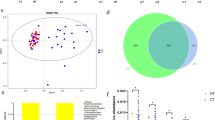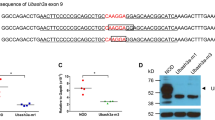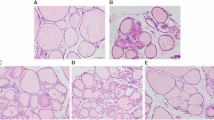Abstract
NOD.H2k and NOD.H2h4 mice carry the major histocompatibility complex (MHC) class II molecule I-Ak associated with susceptibility to experimentally induced thyroiditis. Dietary iodine-enhanced spontaneous thyroid autoimmunity, well known in NOD.H2h4 mice, has not been investigated in NOD.H2k mice. We compared NOD.H2h4 and NOD.H2k strains for thyroiditis and autoantibodies to thyroglobulin (TgAb) and thyroid peroxidase (TPOAb) without or with dietary sodium iodide (NaI) for up to 32 weeks. TgAb levels were significantly higher in NOD.H2h4 compared with NOD.H2k mice on NaI, and TPOAb developed in NOD.H2h4 mice but not in NOD.H2k mice. DNA exome analysis revealed, in addition to the differences in the chromosome (Chr) 17 MHC regions, that NOD.H2k mice, and particularly NOD.H2h4 mice, have substantial non-MHC parental DNA. KEGG (Kyoto Encyclopedia of Genes and Genomes) pathway analysis highlighted thyroid autoimmunity and immune-response genes on Chr 17 but not on Chr 7, and 15 parental B10.A4R DNA. Studies of parental strains provided no evidence for non-MHC gene contributions. The exon 10 Tg haplotype, associated with experimentally induced thyroiditis, is absent in NOD.H2h4 and NOD.H2k mice and is not a marker for spontaneous murine thyroid autoimmunity. In conclusion, the absence of I-E is a likely explanation for the difference between NOD.H2h4 and NOD.H2k mice in TgAb levels and, as in humans, autoantibody spreading to TPO.
This is a preview of subscription content, access via your institution
Access options
Subscribe to this journal
Receive 6 digital issues and online access to articles
$119.00 per year
only $19.83 per issue
Buy this article
- Purchase on Springer Link
- Instant access to full article PDF
Prices may be subject to local taxes which are calculated during checkout





Similar content being viewed by others
References
Hollowell JG, Staehling NW, Flanders WD, Hannon WH, Gunter EW, Spencer CA et al. T(4), and thyroid antibodies in the United States population (1988 to 1994): National Health and Nutrition Examination Survey (NHANES III). J Clin Endocrinol Metab 2002; 87: 489–499.
Podolin PL, Pressey A, DeLarato NH, Fischer PA, Peterson LB, Wicker LS . I-E+ nonobese diabetic mice develop insulitis and diabetes. J Exp Med 1993; 178: 793–803.
Rasooly L, Burek CL, Rose NR . Iodine-induced autoimmune thyroiditis in NOD-H2h4 mice. Clin Immunol Immunopathol 1996; 81: 287–292.
Braley-Mullen H, Sharp GC, Medling B, Tang H . Spontaneous autoimmune thyroiditis in NOD.H-2h4 mice. J Autoimmun 1999; 12: 157–165.
Hutchings PR, Verma S, Phillips JM, Harach SZ, Howlett S, Cooke A . Both CD4(+) T cells and CD8(+) T cells are required for iodine accelerated thyroiditis in NOD mice. Cell Immunol 1999; 192: 113–121.
Chen CR, Hamidi S, Braley-Mullen H, Nagayama Y, Bresee C, Aliesky HA et al. Antibodies to thyroid peroxidase arise spontaneously with age in NOD.H-2h4 mice and appear after thyroglobulin antibodies. Endocrinology 2010; 151: 4583–4593.
Pedersen I, Knudsen N, Carle A, Vejbjerg P, Jorgensen T, Perrild H et al. A cautious iodization program bringing iodine intake to a low recommended level is associated with an increase in the prevalence of thyroid autoantibodies in the population. Clin Endocrinol (Oxf) 2011; 75: 120–126.
Vanderpump M . Thyroid autoimmunity following an iodization programme. Clin Endocrinol (Oxf) 2011; 75: 10–11.
Nishimoto H, Kikutani H, Yamamura K, Kishimoto T . Prevention of autoimmune insulitis by expression of I-E molecules in NOD mice. Nature 1987; 328: 432–434.
Lund T, O'Reilly L, Hutchings P, Kanagawa O, Simpson E, Gravely R et al. Prevention of insulin-dependent diabetes mellitus in non-obese diabetic mice by transgenes encoding modified I-A beta-chain or normal I-E alpha-chain. Nature 1990; 345: 727–729.
Vladutiu AO, Rose NR . Autoimmune murine thyroiditis relation to histocompatibility (H-2) type. Science 1971; 174: 1137–1139.
Beisel KW, David CS, Giraldo AA, Kong YM, Rose NR . Regulation of experimental autoimmune thyroiditis: mapping of susceptibility to the I-A subregion of the mouse H-2. Immunogenetics 1982; 15: 427–430.
Yu S, Medling B, Yagita H, Braley-Mullen H . Characteristics of inflammatory cells in spontaneous autoimmune thyroiditis of NOD.H-2h4 mice. J Autoimmun 2001; 16: 37–46.
Nagayama Y, Horie I, Saitoh O, Nakahara M, Abiru N . CD4+CD25+ naturally occurring regulatory T cells and not lymphopenia play a role in the pathogenesis of iodide-induced autoimmune thyroiditis in NOD-H2h4 mice. J Autoimmu 2007; 29((2–3): 195–202.
Sharma R, Traore K, Trush MA, Rose NR, Burek CL . Intracellular adhesion molecule-1 up-regulation on thyrocytes by iodine of non-obese diabetic.H2(h4) mice is reactive oxygen species-dependent. Clin Exp Immunol 2008; 152: 13–20.
Ellis JS, Hong SH, Zaghouani H, Braley-Mullen H . Reduced effectiveness of CD4+Foxp3+ regulatory T cells in CD28-deficient NOD.H-2h4 mice leads to increased severity of spontaneous autoimmune thyroiditis. J Immunol 2013; 191: 4940–4949.
Hong SH, Braley-Mullen H . Follicular B cells in thyroids of mice with spontaneous autoimmune thyroiditis contribute to disease pathogenesis and are targets of anti-CD20 antibody therapy. J Immunol 2014; 192: 897–905.
Weatherall D, Sarvetnick N, Shizuru JA . Genetic control of diabetes mellitus. Diabetologia 1992; 35: S1–S7.
Wicker LS, Todd JA, Peterson LB . Genetic control of autoimmune diabetes in the NOD mouse. Annu Rev Immunol 1995; 13: 179–200.
Damotte D, Colomb E, Cailleau C, Brousse N, Charreire J, Carnaud C . Analysis of susceptibility of NOD mice to spontaneous and experimentally induced thyroiditis. Eur J Immunol 1997; 27: 2854–2862.
Boulard O, Damotte D, Deruytter N, Fluteau G, Carnaud C, Garchon HJ . An interval tightly linked to but distinct from the H2 complex controls both overt diabetes (Idd16) and chronic experimental autoimmune thyroiditis (Ceat1) in nonobese diabetic mice. Diabetes 2002; 51: 2141–2147.
Lesage S, Hartley SB, Akkaraju S, Wilson J, Townsend M, Goodnow CC . Failure to censor forbidden clones of CD4 T cells in autoimmune diabetes. J Exp Med 2002; 196: 1175–1188.
Liston A, Lesage S, Gray DH, O'Reilly LA, Strasser A, Fahrer AM et al. Generalized resistance to thymic deletion in the NOD mouse; a polygenic trait characterized by defective induction of Bim. Immunity 2004; 21: 817–830.
Guimont-Desrochers F, Cappello ZJ, Chagnon M, McDuffie M, Lesage S . Cutting edge: genetic characterization of IFN-producing killer dendritic cells. J Immunol 2009; 182: 5193–5197.
Tomer Y, Greenberg DA, Concepcion E, Ban Y, Davies TF . Thyroglobulin is a thyroid specific gene for the familial autoimmune thyroid diseases. J Clin Endocrinol Metab 2002; 87: 404–407.
Ban Y, Greenberg DA, Concepcion E, Skrabanek L, Villanueva R, Tomer Y . Amino acid substitutions in the thyroglobulin gene are associated with susceptibility to human and murine autoimmune thyroid disease. Proc Natl Acad Sci USA 2003; 100: 15119–15124.
McLachlan SM, Nagayama Y, Pichurin PN, Mizutori Y, Chen CR, Misharin A et al. The link between Graves' disease and Hashimoto's thyroiditis: a role for regulatory T cells. Endocrinology 2007; 148: 5724–5733.
Kolypetri P, Carayanniotis G . Apoptosis of NOD.H2h4 thyrocytes by low concentrations of iodide is associated with impaired control of oxidative stress. Thyroid 2014; 24: 1170–1178.
Hillhouse EE, Collin R, Chabot-Roy G, Guyon MJ, Tessier N et al. Nearby construction impedes the progression to overt autoimmune diabetes in NOD mice. J Diabetes Res 2013; 2013: 620313.
Esquivel PS, Rose NR, Kong YC . Induction of autoimmunity in good and poor responder mice with mouse thyroglobulin and lipopolysaccharide. J Exp Med 1977; 145: 1250–1263.
Li X, Golden J, Faustman DL . Faulty major histocompatibility complex class II I-E expression is associated with autoimmunity in diverse strains of mice. Autoantibodies, insulitis, and sialadenitis. Diabetes 1993; 42: 1166–1172.
Ni PP, Wang Y, Allen PM . Both positive and negative effects on immune responses by expression of a second class II MHC molecule. Mol Immunol 2014; 62: 199–208.
McLachlan SM, Aliesky HA, Chen CR, Chong G, Rapoport B . Breaking tolerance in transgenic mice expressing the human TSH receptor A-subunit: thyroiditis, epitope spreading and adjuvant as a 'double edged sword'. PLoS One 2012; 7: e43517.
Ruf J, Toubert M, Czarnocka B, Durand-Gorde J, Ferrand M, Carayon P . Relationship between immunological structure and biochemical properties of human thyroid peroxidase. Endocrinology 1989; 125: 1211–1218.
Dennis Jr G, Sherman BT, Hosack DA, Yang J, Gao W, Lane HC et al. DAVID: Database for Annotation, Visualization, and Integrated Discovery. Genome Biol 2003; 4: P3.
Quartey-Papafio R, Lund T, Chandler P, Picard J, Ozegbe P, Day S et al. Aspartate at position 57 of nonobese diabetic I-Ag7 beta-chain diminishes the spontaneous incidence of insulin-dependent diabetes mellitus. J Immunol 1995; 154: 5567–5575.
Acknowledgements
We thank Dr Yaron Tomer (Division of Endocrinology, Department of Medicine, Mount Sinai School of Medicine) for determining the exon 10 Tg haplotypes in DNA from NOD.H2h4, NOD and B10.A4 R mice. We also thank Fanny DeWilde for her help in the animal housing facility in Montreal and Catherine Bresee (Cedars-Sinai Medical Center) for statistical advice. We are grateful to Dr Jean Ruf (INSERM-URA, Faculté de Médecine, Marseille, France) for generously providing us with mouse monoclonal antibodies to human TPO. This work was supported by the following grants: NIH DK 54684, NIH DK 082390 (to SMM) and Canadian Diabetes Association OG-3-13-4018 (to SL).
Author information
Authors and Affiliations
Corresponding author
Ethics declarations
Competing interests
The authors declare no conflict of interest.
Additional information
Supplementary Information accompanies this paper on Genes and Immunity website
Rights and permissions
About this article
Cite this article
Pelletier, AN., Aliesky, H., Banuelos, B. et al. Evidence that MHC I-E dampens thyroid autoantibodies and prevents spreading to a second thyroid autoantigen in I-Ak NOD mice. Genes Immun 16, 268–274 (2015). https://doi.org/10.1038/gene.2015.7
Received:
Revised:
Accepted:
Published:
Issue Date:
DOI: https://doi.org/10.1038/gene.2015.7



